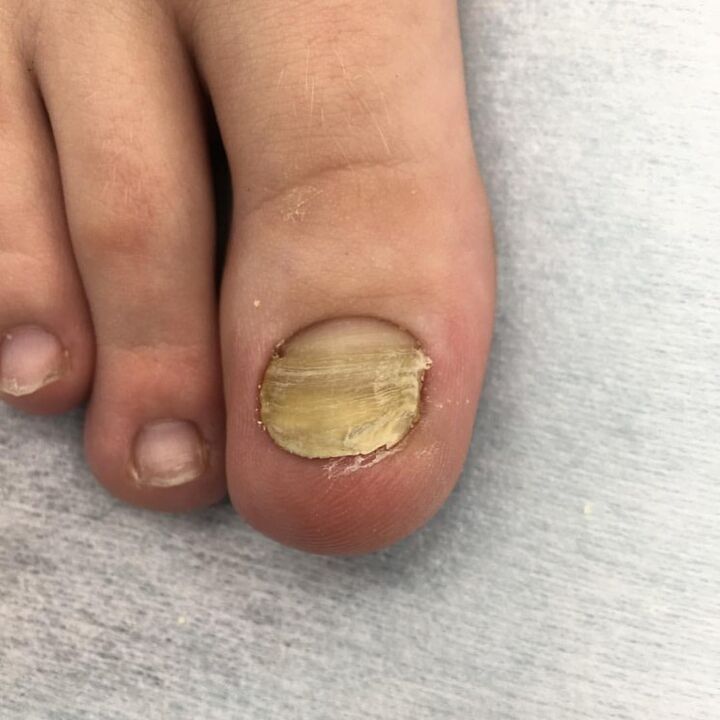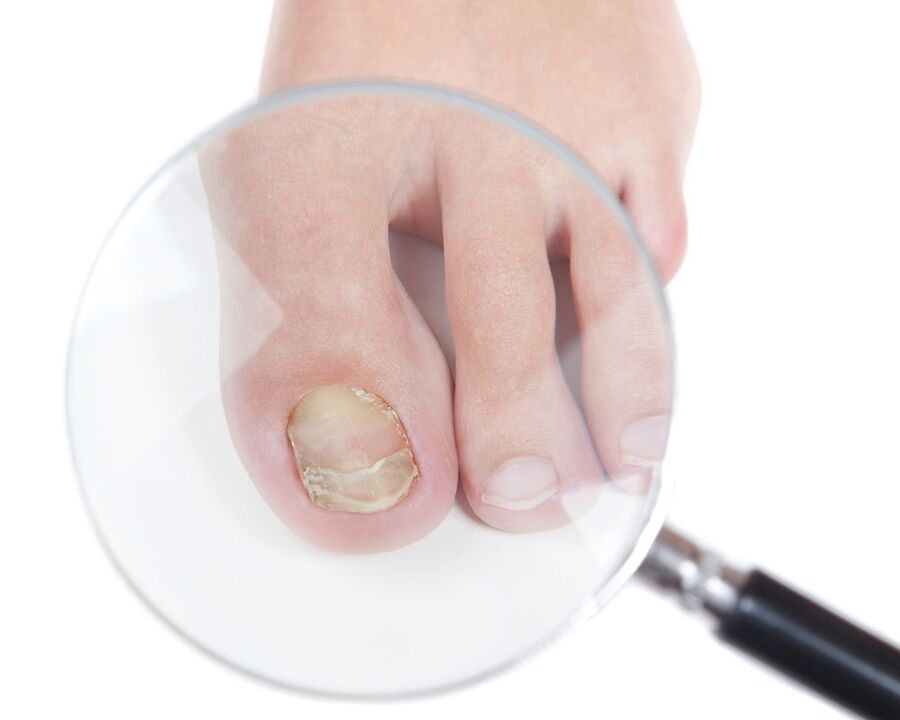Onychomycosis - damage to the nails with a fungal infection. The disease occurs in 5-10% of the population and, among other things, is around 30%.
The causes of onychomycosis
The nail plates of the feet are infected mainly in public baths, saunas and swimming pools. Scales with pathogenic mushrooms that fall in patients with onychomycosis fall on the floors, benches, poles, paths, carpets and garbage. Under conditions with high humidity, fungi can not only exist for a long time, but also increase, especially with unpainted wooden benches and bars, which makes it an intensive source of infection.

Onychomycosis is often transferred in the family when general shoes, towels, washcloths, the inadequate processing of the bath after washing as well as carpets and bars in the bathroom are not used enough. The hands usually appear on the skin when combing the focal points.
The occurrence of onychomycosis is made easier by trauma of nails, especially several (in the case of athletes), the blood supply to the limbs, serious diseases (diabetes mellitus, immune deficiency, blood disease).
Onychomycosis often occurs in people who have long received antibacterial, corticosteroid and immunosuppressive therapy. Second, the lesion of the nail plates occurs: first the mushrooms influence the interdigital folds or the sole and then the nails.
Three types of onychomycosis are differentiated all over the world:
- Normotorophical,
- hypertrophic
- Atrophic.
With a smooth scarring of onychomycosis, only the color of the nails changes: In their extreme departments, stains and stripes appear, the color of which varies from white to protection. Gradually, the entire nail changes the color and keeps shining and normal thickness.
In the case of a hypertrophic type, the color changes, the nail loses its shine, becomes dull, thickens and is partially deformed, especially from the sides. Patients often have pain when walking. A typical nail fungus is characterized by a blunt brownish gray color of the affected part of the nail, its thinning and rejection from the box; The bare area is covered with loose layers.
We treat the mushroom
Local antifungals are ineffective with damage to the nail plates. Processing with antifungals, creams, solutions and loses must be pushed mechanically or with keratolytic plasters by removing the affected area of the nail.
The mechanical distance exists when cutting or cutting with biting fragments of the nail plate.
By using keratolytic plasters in the treatment of onychomycosis, you can soften the nail, which means that it is easily and painlessly removed from the surface of the nail bed with a blunt scale or scissors.
A medication is used as a keratolytic remedy that contains an ointment with 1% antifungals and 40% urea. The ointment is applied to the surface of the nail and covered with the connected adhesive and bandage. After a day, the areas affected by onychomycosis are cleaned. The procedures are carried out daily until the affected nails are completely removed. If the affected nail is removed, bars will be used in the future: antifungal lacquer.
- In the first month of treatment, a medication for 6-8 tablets per day (750-1000 mg), in the second in the same dose every other day and then until the cultivation of healthy nail plates is prescribed 2 times a week. It is taken in 3 doses with a teaspoon of vegetable oil. The duration of treatment for brush mycosis is for 4-6 months with mycosis of the feet-9-12 and even 18 months.
- Treatment with the preparation for the mushroom only ensures a healing in 40% of the patients. A combination with nail removal increases the percentage of healing. However, a large number of side effects and a high percentage of the disease return limit their use.

For successful and safe treatment of onychomycosis, it is advisable to keep certain rules with systemic antifungals.
First, the diagnosis should be reliable. The drug should not be prescribed if there is no laboratory confirmation.
After the diagnosis, it is necessary to carefully collect an allergic history. If medication or food that causes allergic reactions or other manifestations of intolerance are found at the same time, your recording should be excluded.
For treatment with systemic antifungal, it is advisable to limit the use of other medicines with the exception of vital.
Prevention and treatment
To prevent stomach -intestine disorders, it is recommended to rule out products that cause bloating through food during treatment: black bread, legumes, milk, cabbage.
The selection of comfortable shoes is of no importance during treatment and after completion. Often, improving the condition of the affected nail clearly correlates with the wearing of non -traumatic shoes, since the pollination of tissues caused by shoes can lead to deterioration or distal nail -onychomycosis. Before the start of treatment, it is advisable to carry out an examination of indicators for general and biochemical blood tests.
Control examinations must be carried out for the first time after 2 weeks and then once a month. Control microscopy - 6 months after the end of the treatment. The identification of the myzel of pathogenic mushrooms serves as an indication for a second course of treatment with preliminary surgical removal of the affected nails.
Prognosis for the treatment of onychomycosis
Despite the high percentage of healing for patients with onychomycosis when using therapy agents, therapy with these medication does not rule out the use of local antifungals. The combination with conservative and surgical removal of nail plates reduces the time to take systemic anti -bactericidal means and increases the effectiveness of the treatment.

























